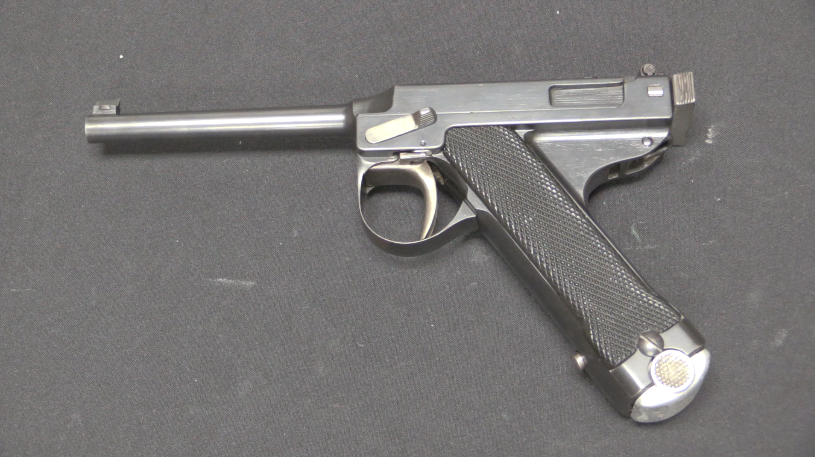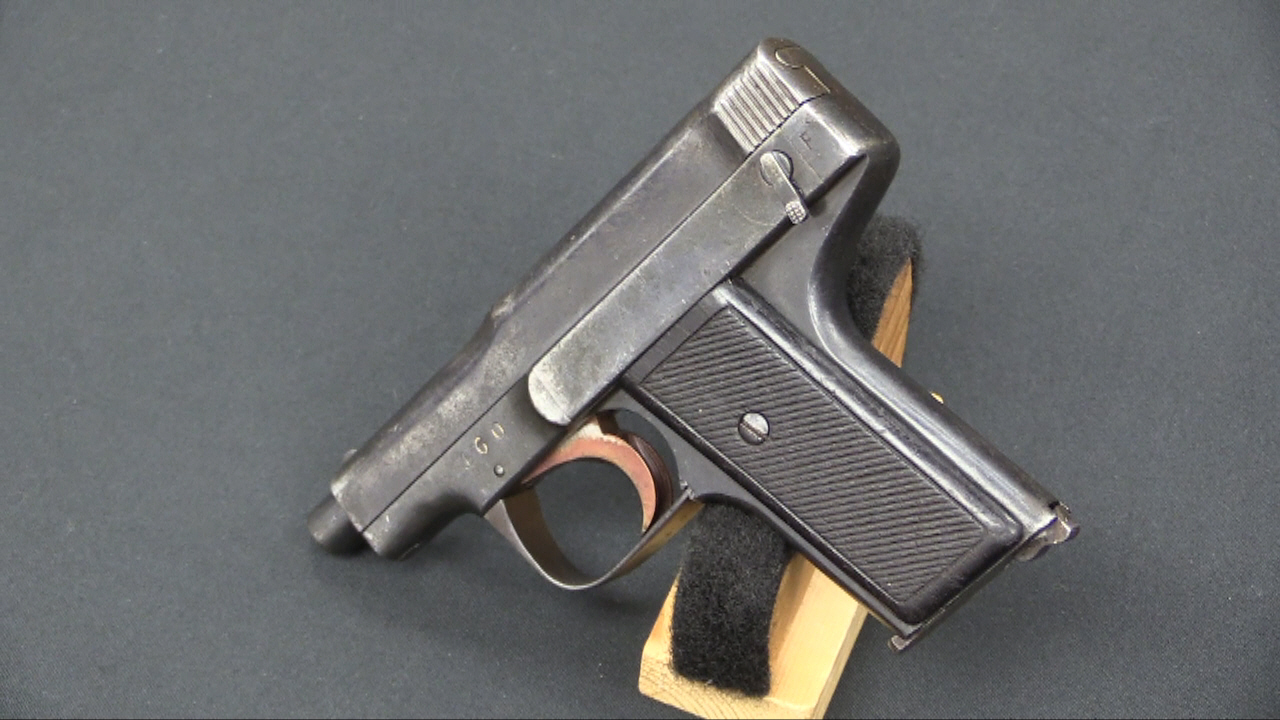This pistol sold for $8,625 at Rock Island on December 2, 2018.
The North China Type 19 pistol (not to be confused with the North China Type 19 rifle) is an improvement on the Type 14 Nambu pistol design which was manufactured in very small numbers in Japanese-occupied China late in World War Two. With shipping connections between Japanese troops in China and the Japanese home islands cut off by US naval activity, plans were put in place to expand Japanese-run arms manufacturing in China and the Type 19 pistol was part of those plans.
The two major improvements to the Nambu design that the Type 19 incorporates are a solid frame with a disassembly lever in place of the removable trigger guard, and a redesign of the manual safety to be much more ergonomic. The magazine retention spring was also wisely discarded. Two distinct types of these pistols are known; one very well made with a bullseye style of final acceptance mark and one of very poor machining quality with a Japanese “2” character as a final proof, presumably indicating second quality. Both types have independent serial number ranges, with recorded numbers from 4 to 55 on the high quality guns and 004 to 093 on the poor ones. The explanation for these two distinct types is not known.
The intention was to produce 5,000 Type 19 pistols, but judging from the known surviving examples no more than about 200 were actually made. This is one of the scarcest Japanese WW2 pistols, and very interesting as an improvement to the Nambu design.




“improvement on the Type 14 Nambu pistol”
I am wondering who was responsible for incorporation of these, considering that 1930s Japanese culture did not prompt lower ranking people to correct work of higher ranking, to say it mildly.
“was manufactured in very small numbers in Japanese-occupied China late in World War Two.”
Were parts of these automatic pistol actually interchangeable with original Nambu? If not was it planned to be so, but failed or it was never required?
“The explanation for these two distinct types is not known.”
My first though is that it might be produced in two different places.
Drat, we don’t know if the striker spring was strengthened in this design. I recall that the Type 94 replaced the striker with a concealed hammer and had no problem with trigger reliability, so long as it was not deliberately abused or used as a bludgeon held by the barrel…
The latter being particularly hazardous due to the exposed sear bar on the left side of the frame. If accidentally depressed, it released the hammer without recourse to the trigger. Oops.
I’ve often wondered how many ADs there were with the Type 94, in the holster, when the wearer inadvertently bumped it against something hard enough to squeeze the holster and depress that sear bar.
The “hard-shell” Type 14 holster might prevent that, but the “soft-side” chest holster used by IJA and IJN pilots would seem to be a potential personal safety hazard with this pistol.
cheers
eon
To my understanding, the Type 94 was carried in the holster without a round in the chamber at anytime of day. The gun would be racked on the draw, sidestepping the hazard of accidental discharge. Anyone foolish enough to jam his gun into the holster with a round still in the chamber, with a finger still on the trigger, and with the safety off risks shooting himself or worse, shooting his friend in the knee!
Considering the position and angle-in of the airmen’s chest holster, a more likely result would be the inept airman ending up singing soprano. (see Brannigan, 1975, with The Duke.)
cheers
eon
Furthermore, the manual safety works by blocking the sear, so unintentional firing by depressing the sear with the safety engaged is quite impossible.
The IJA was very strict about correct manual of arms and drill, so any soldier caught with a cocked and unsafe pistol in the holster would receive a literal flogging, and not a light one, either. This was an an army where beating the recruits during boot camp was a standard part of training even if they had not done anything wrong. Punishments for actually breaking the rules and procedures were severe.
So, perhaps no surprisingly, there are no confirmed historical cases of AD by depressing the sear with the Type 94. Depressing the sear actually requires quite a bit of force, so it was unlikely to happen when the gun was out of the holster, and bumping the gun to something hard in the holster in unsafe condition did not happen frequently enough that any record of it would survive, if it indeed ever happened.
If better made, it would be a cute pistol. I presume this is in 8mm Nambu caliber.
Now that is a forgotten weapon….outstanding, Ian!
Very true. I second that.
Officers’ sidearms vs. NCOs’ sidearms? Army vs. Navy? My impression of the Japanese includes great factionalism and class-consciousness.
In WWI the British issued flapped holsters to officers and open-top holsters to NCOs. (So the officers’ servants — the batmen — wouldn’t have to clean those revolvers so often?)
Two different factories or production lines, or two different production runs (“Manager-san, please reduce production time imediately!”) make the most sense to me.
The revolver was a secondary weapon for British NCOs already in WW1, I believe, so it had to be quickly available. On the other hand, the revolver was the officers’ only weapon (since swords were generally not carried in WW1 after the onset of the trench warfare¹), so they usually had more time to deliberately draw the revolver.
¹ The British infantry officers’ sword with a 32.5″ blade was too long to be very useful in the trenches and it also immediately revealed its user to be an officer — but so did carrying just a revolver, for the matter.
Curious what use the Communist’s made of these factories after the Japanese and Nationalists left.
Turned it into NORINCO 🙂